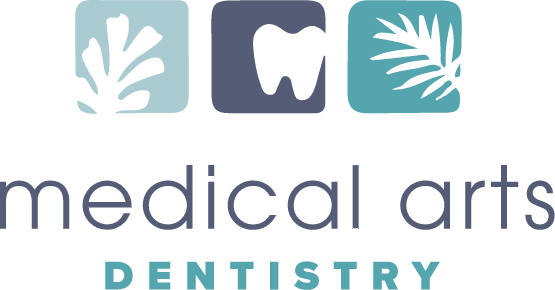When it comes to maintaining good oral health, understanding the concept of plaque is crucial. Plaque is a sticky, colorless film of bacteria that constantly forms on your teeth and along the gumline. This biofilm is a natural part of the oral environment, but if left unchecked, it can lead to a host of dental problems. In this blog from Medical Arts Dentistry, we’ll delve into what plaque is, its consequences, and how you can prevent it to keep your smile bright and healthy.
Plaque: What It Is And Its Causes
Plaque, composed mainly of bacteria, is the result of the interaction between the food you consume and the bacteria that inhabit your mouth. When you eat or drink, particularly foods high in sugars and starches, the bacteria in your mouth feed on these remnants, producing acids as a byproduct. These acids, in turn, can attack the enamel of your teeth, leading to cavities and tooth decay.
One of the key issues with plaque is its tendency to harden over time. When plaque is not adequately removed through regular brushing and flossing, it can mineralize and become tartar, a hard, yellowish substance that adheres to your teeth. Tartar is more challenging to remove and can only be effectively eliminated by a dental professional during a dental cleaning.
Plaque is not only responsible for cavities but also plays a significant role in the development of gum disease. As the bacteria in plaque continue to multiply, they can cause irritation and inflammation of the gums. This initial stage of gum disease is known as gingivitis and is characterized by redness, swelling, and bleeding of the gums. If left untreated, gingivitis can progress into a more severe form of gum disease called periodontitis, which can lead to tooth loss and even affect your overall health.
How To Prevent Plaque Build-up
Preventing plaque buildup is a cornerstone of good oral hygiene. Here are some essential steps to help you keep plaque at bay:
- Brush Regularly: Brush your teeth at least twice a day with fluoride toothpaste. Use a soft-bristle toothbrush and be sure to brush for at least two minutes, paying attention to all surfaces of your teeth.
- Floss Daily: Flossing is a critical part of plaque prevention. It helps remove plaque and food particles from between your teeth and along the gumline where your toothbrush may not reach.
- Mouthwash: Rinsing with an antimicrobial mouthwash can help reduce the bacteria that contribute to plaque formation. Choose a mouthwash that carries the American Dental Association (ADA) seal of approval.
- Balanced Diet: Consume a balanced diet that limits sugary and starchy foods. These foods can encourage bacterial growth and acid production.
- Regular Dental Check-ups: Visit your dentist for regular check-ups and professional cleanings. Your dentist can identify and remove tartar buildup and assess your oral health.
- Quit Smoking: Smoking not only stains your teeth but also increases your risk of gum disease. Quitting smoking can have a positive impact on your oral health.
In conclusion, understanding what plaque is and its role in oral health is essential for maintaining a beautiful and healthy smile. By following a consistent oral hygiene routine, eating a balanced diet, and seeking regular dental care, you can prevent plaque buildup and reduce your risk of dental issues such as cavities and gum disease. Your smile is a valuable asset, and taking steps to prevent plaque is a key component of preserving it for years to come.
How To Help Your Kids Prevent Plaque
Preventing plaque in children is of paramount importance, as establishing good oral hygiene habits at a young age can set the foundation for a lifetime of healthy teeth and gums. Children can adopt some specific practices to minimize plaque buildup and maintain their oral health.
Parents and caregivers play a crucial role in teaching children about the importance of oral hygiene. It’s essential to instill a regular brushing and flossing routine early on. As soon as a child’s baby teeth start to emerge, usually around the age of six months, it’s recommended to start cleaning them with a soft, age-appropriate toothbrush and water. As they get older, transition to using a small amount of fluoride toothpaste and encourage them to brush for two minutes, twice a day. Make brushing a fun and engaging activity by using child-friendly toothpaste flavors and colorful toothbrushes. Supervision and assistance from parents are essential to ensure that children are brushing effectively and consistently.
In addition to brushing, teaching children the proper technique for flossing is vital. Start flossing their teeth as soon as two teeth touch, and as they develop the dexterity, guide them in flossing themselves. Emphasize the importance of reaching between teeth and along the gumline to remove plaque and food particles. Regular dental check-ups for children are equally important, as dentists can provide guidance on proper oral care and identify any issues early on. These visits also offer an opportunity to apply dental sealants or fluoride treatments, which can help protect their teeth from plaque and decay. By following these steps and fostering a positive attitude towards oral health, children can significantly reduce their risk of plaque-related dental problems and enjoy a beautiful, healthy smile.
The Very Best Dental Care For The Whole Family
At Medical Arts Dentistry in Savannah and Georgetown, GA, we believe that straight teeth are not just about having a beautiful smile; they are about promoting better oral and overall health. Investing in orthodontic treatment to achieve straight teeth can lead to improved oral hygiene, reduced risk of gum disease, enhanced digestion, and numerous other health benefits. So, why wait? Call 912-355-0605 to schedule a consultation with our experienced team today and embark on the journey to a healthier, straighter smile that will benefit you for years to come.

